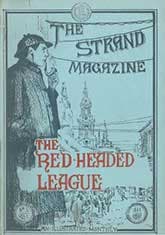The Red-Headed League
Critique • Quotes • Sherlock Holmes at the movies
 First appearance, 1891
First appearance, 1891First publication
1891 in Strand Magazine
First book publication
1892 in The Adventures of Sherlock Holmes
Literature form
Story
Genres
Crime, mystery
Writing language
English
Author's country
England
Length
Approx. 10,500 words
How the trick is done
Starting with its misleading title, "The Red-Headed League" is the first instance I can recall of a certain mystery-writing trick. A bizarre tale is spun about seemingly unrelated events that seem to have no sensible purpose, confusing the victims—and readers—until the crime-solver pulls aside the curtain and explains what has really been going on.
Arthur Conan Doyle used the same approach in several of his own later stories. Other writers have produced variations along these lines with some success. For example, G.K. Chesterton's story, The Blue Cross (1910), has us follow a wild trail of nonsensical clues until we find a certain little priest has solved the case quite directly. Crime novelists have often stretched out this kind of misdirection to great—and sometimes annoying—effect in their longer works, keeping the reader in a state of confusion about what is going on as long as possible.
In "The Red-Headed League", one of the stand-out stories of Doyle's The Adventures of Sherlock Holmes compendium, it's handled brilliantly.
The setup is intriguing. A pawnbroker with red hair answers a newspaper ad and is hired by a seemingly benevolent organization, calling itself "The Red-Headed League", to attend a local office daily for the highly paid but useless work of copying out an encyclopedia. After two months, he finds the office closed and the league dissolved. That's it. Apparently no great crime to be solved. Just some odd personal experiences to explain.
Mysterious chain of events
Faced with this mystery, we mortals ponder the significance of red hair, what the encyclopedia entries are for, and so on. But Sherlock Holmes is not distracted by those details and figures out an actual crime about to take place.
He still doesn't let us in on it though. At one point, he asks directions of the pawnbroker's assistant just to see his knees and he thumps his cane on the street pavement without explanation, adding to the chain of mysterious events.
At the end of the story when he reveals his thinking process and conclusions, they seem, well, obvious.
It's like a magician's trick of misdirection. If afterwards, the magician repeats the trick for you but at the crucial point indicates out where you should be looking to see how the trick is done.... Right, that was simple, wasn't it? How could I have been fooled?
It's worth reading "The Red-Headed League" a second time just to see how skilfully Doyle pulls it off.
— Eric
Critique • Quotes • Sherlock Holmes at the movies

